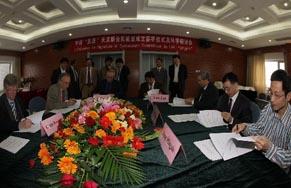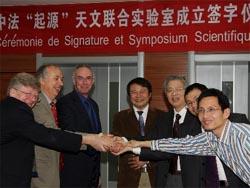

The signing ceremony for co-establishing a China-France internationally associated laboratory in astrophysics is held recently at the National Astronomical Observatories, CAS, in Beijing. Named "Origins," the new lab will be engaged in research into extragalactic astrophysics and cosmology.
The signing ceremony for co-establishing a China-France internationally associated laboratory (Laboratoire International Associ , or LIA, in French) in astrophysics was held on 22 October in Beijing. Among the prestigious participants witnessing the event were French Ambassador H.E. Herve Ladsous and Vice Director-general of the CAS Bureau of International Cooperation QU Juliang.
Named "Origin," LIA will be engaged in research into extragalactic astrophysics and cosmology, focuing on such topics as the formation and evolution of galaxies, dark matter and dark energy, and the nature of sources of high energies including gamma-ray bursts.
The new lab will be made up of astronomers from 11 Chinese institutions, including the National Astronomical Observatories at CAS (NAOC), Beijing University, Nanjing University and the University of Science and Technology of China ; and research groups from 10 French laboratories, such as the National Center for Scientific Research (CNRS) in France, the Paris Observatory, the Pierre & Marie Curie University and Universit Paris-Diderot. It will be co-managed by NAOC and CNRS.
The objective of LIA is to build a strong and jointly managed Franco-Chinese scientific community, with a joint steering committee, leading to regular academic conferences. While many Chinese students and researchers have already worked in French laboratories, the new lab will also enable French researchers to work in China.
LIA will also strengthen other partnerships in the fields of extrasolar planets and instrumentation, particularly space experiments, of radio astronomy, and of future giant telescopes with diameters of 40 m (Extremely Large Telescope).
Related News
Photos
More>>trade
market
- A leap second to be inserted at the New Year's beginning
- CAS to further cooperation with German academia in ocean studies
- Construction of largest aperture radio telescope starts in southwest China
- Premier urges scientists to help fight financial crisis
- CAS researchers receive TAN Jiazhen Awards for Life Sciences
finance
- China's Think Tank Forecasts 8.3% GDP Growth in 2009
- Three Foreign Scientists Received 2008 CAS International Science and Technology
- 1:1,000,000 Geomorphologic Atlas of China to be Released
- Xu Guangxian Received China's 2008 State Top Scientific and Technological Awards
- Is Athlete's Brain Different from That of Average People?





